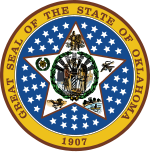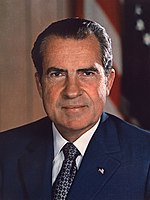| ||||||||||||||||||||||||||
| ||||||||||||||||||||||||||
 County results
Nixon 60–70% 70–80% 80–90%
| ||||||||||||||||||||||||||
| ||||||||||||||||||||||||||
| Elections in Oklahoma |
|---|
 |
|
|
The 1972 United States presidential election in Oklahoma was held on November 7, 1972, as part of the 1972 United States presidential election. Voters chose eight electors, or representatives to the Electoral College, who voted for president and vice president.
Oklahoma voted in a landslide for incumbent Republican President Richard Nixon over his Democratic challenger George McGovern. Nixon's winning margin of 49.70 percentage points made Oklahoma his third-strongest state, behind Mississippi and Georgia,[1] and 26.55 percentage points more Republican than the nation at-large. Although in the twenty-first century Oklahoma has rivaled Wyoming, Utah, Idaho and increasingly West Virginia as the most Republican state in the nation, no presidential candidate in Oklahoma has ever equaled Nixon's margin of victory. Indeed, in the eleven presidential elections since this one, only twice has any state been carried by a larger percentage margin – both by Ronald Reagan in Utah, as part of the 1980 and 1984 elections.
Nixon carried with over sixty percent of the vote all seventy-seven counties in the state, four years after he had won Oklahoma despite finishing behind both Democrat Hubert Humphrey and American Independent George Wallace in Atoka, Choctaw, Love, McCurtain and Pushmataha counties.[2] American Independent John G. Schmitz was the only other candidate on the ballot, and he received 2.30 percent of the vote, although managing over eleven percent in the Panhandle county of Cimarron. Nixon's feat of winning every county in Oklahoma would not be achieved by any presidential candidate again until George W. Bush did so in 2004, since when every county has stayed in the GOP column in presidential elections. This was the last time until 2004 that Hughes County and Haskell County voted Republican in a presidential election. Carter, Cotton, Harmon, Jackson, Jefferson, Murray, and Tillman counties voted Republican for the first time since 1928; Bryan, Choctaw, Coal, Johnston, McCurtain, and Love counties for the first time ever; and Latimer and Pittsburg counties since 1920.
In archconservative Oklahoma, McGovern was uniformly viewed as a left-wing extremist because of his support for busing and civil rights, plus his opposition to the Vietnam War, support for granting amnesty to draft dodgers[3] and support for a thousand-dollar giveaway to each American as a solution to poverty.[4] Many, especially Republican campaigners, also believed McGovern would legalise abortion and illicit drugs if he were elected[5] – despite the fact that his running mate Sargent Shriver was firmly anti-abortion.
Consequently, even the most loyal Southern Democrats from the southeastern part of the state almost completely deserted their traditional party for Nixon: Bryan, Coal, Johnston, and the above-mentioned Choctaw, Love and McCurtain counties deserted their traditional Democratic Party for the first time ever.[6] Nixon also almost completely captured the twenty percent of Oklahoman voters who had supported Wallace in 1968:[7] exit polls suggested he won them over McGovern by a ratio of ten to one, and in the two Wallace counties of Pushmataha and Atoka Nixon totaled over seventy percent of the vote which increased from around thirty percent in 1968.
- ^ "1972 Presidential Election Statistics". Dave Leip’s Atlas of U.S. Presidential Elections. Retrieved March 5, 2018.
- ^ Dave Leip’s Atlas of U.S. Presidential Elections; 1968 Presidential General Election Results – Oklahoma
- ^ Perry, James Moorhead; Us and Them: How the Press Covered the 1972 Election, p. 136 ISBN 0517505525.
- ^ Grantham, Dewey W.; The Life and Death of the Solid South: A Political History, p. 179 ISBN 0813148723.
- ^ Davis, Lanny; Scandal: How "Gotcha" Politics Is Destroying America, pp. 65–66 ISBN 1466892803.
- ^ Menendez Albert J.; The Geography of Presidential Elections in the United States, pp. 99, 282–283 ISBN 0786422173.
- ^ See Judis, John B., and Teixeira, Ruy; The Emerging Democratic Majority, p. 19 ISBN 0743254783.

